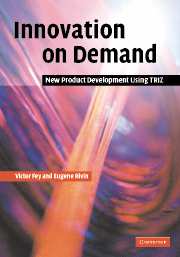Book contents
- Frontmatter
- Contents
- Preface
- 1 Introduction
- 2 Resolving system conflicts
- 3 Basics of the substance–field analysis
- 4 Algorithm for inventive problem solving (ARIZ)
- 5 Laws of technological system evolution
- 6 Guiding technology evolution
- Appendix 1 Genrikh Altshuller – the creator of TRIZ
- Appendix 2 System conflict matrix and inventive principles
- Appendix 3 Standard approaches to solving inventive problems
- Appendix 4 Using TRIZ in management practice
- Appendix 5 Glossary
- References
- Index
2 - Resolving system conflicts
Published online by Cambridge University Press: 14 January 2010
- Frontmatter
- Contents
- Preface
- 1 Introduction
- 2 Resolving system conflicts
- 3 Basics of the substance–field analysis
- 4 Algorithm for inventive problem solving (ARIZ)
- 5 Laws of technological system evolution
- 6 Guiding technology evolution
- Appendix 1 Genrikh Altshuller – the creator of TRIZ
- Appendix 2 System conflict matrix and inventive principles
- Appendix 3 Standard approaches to solving inventive problems
- Appendix 4 Using TRIZ in management practice
- Appendix 5 Glossary
- References
- Index
Summary
Problem solving is the core of concept development. Solving problems usually starts with attempts to find solutions by using conventional means. Frequently, however, such an approach does not work. Suppose, for example, that we want to enhance the comfort of a car. One of the simplest known ways to achieve this goal is to enlarge the passenger compartment. This will result in increased weight and size (drag resistance), and consequently in increased fuel consumption. Thus, gaining advantage in one part of the car will be negated by disadvantages in other parts.
An engineering design problem becomes difficult when attempts to meet one constraint make another constraint, or constraints, unattainable. Designers are usually taught that it is impossible to have the “best of both worlds,” so they take for granted that trade-offs are unavoidable.
There is not a universal approach to distinguish the best trade-off from a variety of potential options. Much effort is spent on trade-off studies, but rarely can the engineer claim that the selected trade-off is the best one possible, and that the entire design space was examined. As a rule, many products and processes are designed with less than optimal performance.
Another, more fundamental, concern is the very nature of trade-offs, which is an incomplete fulfillment of opposing requirements. In other words, trade-offs are inherently suboptimal designs.
This chapter describes concepts and tools of TRIZ that make developing trade-off-free – i.e., breakthrough – designs possible.
- Type
- Chapter
- Information
- Innovation on DemandNew Product Development Using TRIZ, pp. 11 - 46Publisher: Cambridge University PressPrint publication year: 2005

